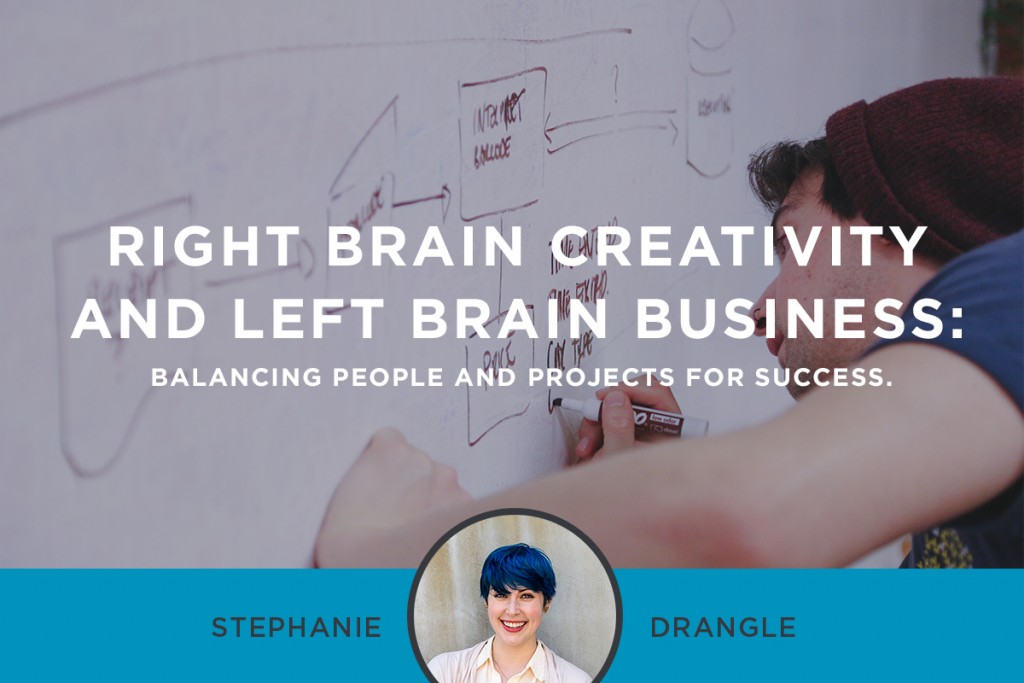When the average person imagines an advertising agency, thoughts of paper basketball tournaments and indoor golf courses come to mind. Bouncing ideas off each other over pizza and beer at 11 a.m. and playing video games in the office common room until genius strikes.
Unfortunately, not all creative projects can wait for the buzz to wear off or for the Creative Director to level up before he turns off the game.
The reason these scenarios come to mind when people think of agencies is that creativity lives in an intangible, idyllic haven of imagination. But to utilize the foundation of a right-brained “creative,” a more left-brained approach of schedules, budgets and process is required. Having the idea is not the same as seeing that idea to lucrative fruition.
It’s natural for people who lean toward a right-brained functionality to gravitate to creative professions like artists and therapists. And accountants and engineers are overwhelmingly categorized as left brained.
But being inherently right or left brained unfortunately does not exclude anyone from certain tasks that aren’t a natural fit. It just makes those tasks harder to accomplish.
As the production manager, it’s my job to work with the strengths and weaknesses of my left- and right-brained coworkers to facilitate a successful product. And I do that by using several different techniques to keep creative projects and creative people on track and on task.
[Tweet “Having the idea is not the same as seeing that idea to lucrative fruition.”]
Have Clear Metrics for Success.
At Thoma, we have some “absolute,” clear guidelines for success that can be tracked and followed by the entire team.
With these metrics and processes, I utilize the standards we have in place to help right-brain people function within the typically left-brained boundaries a business requires. In fact, it’s the scheduling, budgeting and structure that come first, not the creativity. So by the time a project moves into the creative department, it already has a strong foundation of milestones and deadlines, along with a clear guideline for how our team will be successful.
Talk to the Team.
I talk to my creative team and find out what strategies work for them. If I have the power to make my coworkers’ jobs easier, I’m going to use that power. If I have a designer who really benefits from constructive feedback, I won’t schedule three days for her to sit alone and work on a project in a vacuum. I’ll build in several internal reviews so that she gets the feedback she needs to develop her best work.
Keep it Flexible.
I’m also willing to be flexible when it’s necessary but I know when to hold project deadlines and milestones firm.
If a team member comes to me — right brain or left brain — and says they need more time, I have to be flexible. If the right idea isn’t coming or more research needs to be done before we hit on the proper strategy, then I make the adjustments that allow for further creative development. No one can force a good idea to appear, and recognizing that is the first step to constructing an environment that fosters creativity instead of stifling it.
Know When to Be Inflexible.
Now, I may pad a deadline because I know a certain creative team member is consistently two days late on all projects. But I may also need to have a hard conversation with that same coworker to let them know they’ll be working late to meet a deadline. Being in constant communication with my team allows me more insight into whether a coworker is truly struggling, or if they got distracted and just didn’t finish their work. And there are projects that have hard deadlines, deadlines that move for no brain, left or right, and everyone is accountable for those.
It’s a balancing act to manage a right-brained person who may not typically work within time-sensitive confines. Trying to force someone to develop an inventive, ingenious idea or design with too many boundaries often backfires. But with no boundaries, the client won’t stick around. By providing plenty of time for revisions and giving right-brained individuals some control over their own schedule, both parties get what they want. The scheduling and steps in the process satisfy the client and shape the accountability between coworkers that enables every left and right brain to work together as a team.
